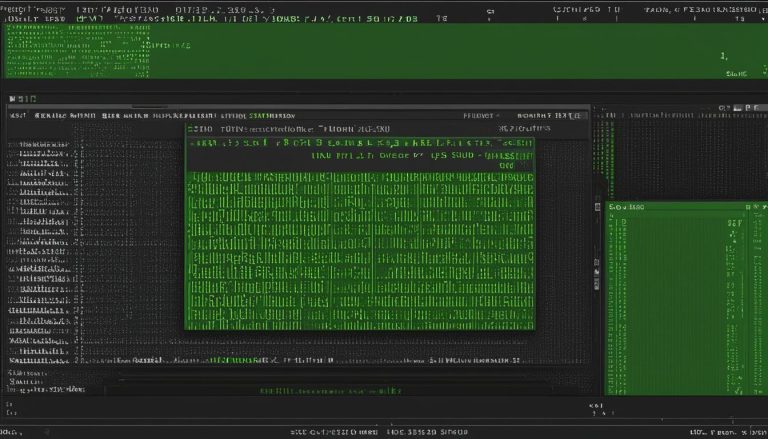CentOS Stream is a Linux® distribution that serves as a development platform for open-source community members to contribute to the upstream development of Red Hat® Enterprise Linux. It provides transparency and opportunities for community, partner, and customer participation. CentOS Stream allows early access to the source code used to produce the next version of Red Hat Enterprise Linux, enabling users to contribute directly to its development and test their workloads before new releases are published.
Key Takeaways:
- CentOS Stream is a Linux distribution for community contributions to Red Hat Enterprise Linux development.
- It provides early access to source code and opportunities for transparency and collaboration.
- CentOS Stream allows users to test their workloads before new releases are published.
- Contributing to CentOS Stream enables direct involvement in the development of Red Hat Enterprise Linux.
- CentOS Stream is not recommended for production environments requiring stability.
The Role of CentOS Stream in Red Hat Enterprise Linux Development
CentOS Stream plays a crucial role in the development process of Red Hat Enterprise Linux. It serves as the bridge between the upstream project Fedora and the downstream development for Red Hat Enterprise Linux. It allows ISV, IHV, and other ecosystem developers to collaborate with the Fedora Project, shortening the feedback loop and ensuring all voices are heard in the creation of future Red Hat Enterprise Linux versions. CentOS Stream follows a continuous release model, providing frequent updates and a preview of the upcoming minor releases of Red Hat Enterprise Linux.
The CentOS Stream release cycle follows a predictable pattern, making it easier for developers and users to plan and prepare for updates. It provides a balance between stability and innovation, allowing users to stay up to date with the latest features and improvements while maintaining a reliable and tested platform. CentOS Stream updates are released more frequently than Red Hat Enterprise Linux minor releases, offering users the opportunity to test new functionalities and provide feedback to shape the final product.
The CentOS Stream community is actively involved in the development and improvement of the distribution. Collaborative efforts are encouraged, and community members can contribute code, participate in testing, and provide input on the future direction of CentOS Stream. Documentation is available to help users navigate the development process, understand the release cycle, and contribute effectively. The CentOS Stream community fosters a culture of openness and transparency, allowing users to engage with Red Hat engineers and fellow community members to drive innovation and ensure a robust and reliable platform.
| CentOS Stream Release Cycle | Updates Frequency | Community Involvement | Documentation Availability |
|---|---|---|---|
| Continuous release model | Frequent updates | Active community participation | Comprehensive documentation |
The role of CentOS Stream in Red Hat Enterprise Linux development is essential for creating a robust, stable, and innovative operating system. It provides a platform for collaboration and feedback, allowing developers and users to contribute to the future of Red Hat Enterprise Linux. With its predictable release cycle, frequent updates, active community involvement, and comprehensive documentation, CentOS Stream empowers users to stay ahead of the curve and actively shape the direction of the distribution.
Migrating from CentOS Linux to CentOS Stream
For current CentOS Linux users who will need to migrate between 2021 and 2024, CentOS Stream offers a migration path that allows them to participate in the development of future versions of Red Hat Enterprise Linux. Although migrating from CentOS Linux to CentOS Stream is straightforward, there is no easy process for moving from CentOS Stream to another Linux distribution. Red Hat’s Convert2RHEL tool can be used to migrate CentOS Linux systems directly into Red Hat Enterprise Linux systems, but it does not work with CentOS Stream. Users opting for CentOS Stream as an interim before transitioning to Red Hat Enterprise Linux will need to reinstall their operating system from the repository.
To facilitate the migration process, CentOS Stream provides detailed documentation and resources explaining the steps involved in migrating from CentOS Linux. These resources can be accessed on the CentOS Stream website and provide guidance on how to perform a smooth transition. It is recommended to thoroughly review the migration documentation and make a backup of any important data before proceeding with the migration process.
Additionally, CentOS Stream offers a forum and community support where users can seek assistance and share their experiences with the migration process. This community-driven approach ensures that users have access to valuable insights and best practices from others who have already migrated from CentOS Linux to CentOS Stream. The community support can be particularly helpful in resolving any specific issues or challenges that may arise during the migration process.
“Migrating from CentOS Linux to CentOS Stream provides an opportunity for users to contribute directly to the development of Red Hat Enterprise Linux and stay updated with the latest advancements in the open-source community. While the migration process may require some effort, CentOS Stream offers a seamless path for users to continue benefiting from the features and benefits of the CentOS ecosystem.”
CentOS Stream vs CentOS Linux: Understanding the Differences
CentOS Stream and CentOS Linux are two distinct distributions that differ in their purpose and role in the development process. Understanding the differences between these two versions of CentOS is essential for users looking to make an informed decision about which distribution to choose.
CentOS Linux is a downstream distribution of Red Hat Enterprise Linux (RHEL), commonly used for development and deployment. It provides a stable and reliable operating system for users who prioritize stability and long-term support. However, CentOS Linux will discontinue updates between 2021 and 2024, leaving users in need of an alternative for ongoing support and development.
On the other hand, CentOS Stream serves as an upstream development platform for future versions of RHEL. It provides a continuous stream of content, allowing for frequent updates and the ability to contribute directly to the development of Red Hat Enterprise Linux. CentOS Stream offers users early access to the same code used by Red Hat developers, enabling them to contribute new features, patches, and tests to improve the capabilities and security of upcoming RHEL releases.
In summary, CentOS Stream differs from CentOS Linux in its contribution model, update frequency, and its role as an upstream development platform. While CentOS Linux is suitable for stable deployments, CentOS Stream is designed for users who want to contribute to the future development of RHEL and have early access to new features and updates. Understanding these differences is key to choosing the most appropriate distribution for your specific needs.
Comparison Table: CentOS Stream vs CentOS Linux
| Feature | CentOS Stream | CentOS Linux |
|---|---|---|
| Contribution Model | Allows direct contribution to RHEL development | Stable distribution for development and deployment |
| Update Frequency | Frequent updates and continuous stream of content | Discontinued updates between 2021 and 2024 |
| Role in Development | Upstream development platform for future RHEL versions | Downstream distribution of RHEL |
| Target Audience | Users who want to contribute and have early access to new features | Users seeking stability and long-term support |
CentOS Stream and Stability: Is it Suitable for Production Use?
When considering CentOS Stream for production environments, it is essential to evaluate its stability and suitability. CentOS Stream is a rolling release distribution that offers frequent updates and allows for direct participation in the development of future versions of Red Hat Enterprise Linux. However, due to its continuous evolution and focus on upstream development, CentOS Stream may not provide the level of stability required for critical business applications and workloads.
In production environments, organizations rely on the stability and support provided by their operating systems to ensure uninterrupted operations and minimize the risk of disruptions. CentOS Stream’s continuous stream of content and frequent updates can introduce unpredictability and potential compatibility issues that might impact critical systems and workflows.
For organizations seeking a stable and supported operating system, Red Hat Enterprise Linux is the recommended option. Red Hat Enterprise Linux is known for its rigorous testing, certification processes, and long-term support. It provides a reliable foundation for production workloads and offers comprehensive support from Red Hat, ensuring prompt resolution of any issues that may arise. CentOS Stream, on the other hand, is better suited for developers and enthusiasts who are interested in contributing to the development of Red Hat Enterprise Linux and testing their workloads before new releases are published.
CentOS Stream is not recommended as a production-grade platform for important business applications and workloads that require stability.
CentOS Stream and the CentOS Project’s Shift
The CentOS Project has undergone a significant shift in its focus, with CentOS Stream now taking center stage. This change has sparked concerns among current CentOS Linux users, causing them to seek alternatives such as AlmaLinux and Rocky Linux as potential replacements. While CentOS Stream offers a migration path for CentOS Linux users, it’s important to consider other Linux distributions for long-term stability and support.
The CentOS Project’s decision to prioritize CentOS Stream reflects a new approach to upstream development for Red Hat Enterprise Linux. CentOS Stream serves as a development platform for future versions of Red Hat Enterprise Linux, providing users with early access to upcoming releases. However, it’s worth noting that CentOS Stream is a rolling release distribution that continuously evolves, potentially lacking the level of stability required for critical production environments.
As the CentOS Project undergoes this shift, it’s vital to carefully evaluate the specific needs and requirements of your organization. Exploring alternative Linux distributions and considering long-term support options will ensure a well-informed decision when it comes to migrating to CentOS Stream or other suitable alternatives. The future of CentOS lies in CentOS Stream, but determining its compatibility with your business operations is crucial for a successful transition.
Community and Collaboration in CentOS Stream
CentOS Stream fosters a vibrant community of developers and contributors who play an integral role in shaping the future of Red Hat Enterprise Linux. With early access to the same code used by Red Hat developers, community members can actively participate in the development process and provide valuable feedback on upcoming releases.
The CentOS Stream community is a diverse ecosystem of individuals, organizations, and partners who share a common goal of driving innovation and improving the capabilities of Red Hat Enterprise Linux. By collaborating and contributing to CentOS Stream, developers have the opportunity to showcase their expertise, contribute new features and enhancements, and ensure the compatibility and security of future releases.
Testing is a critical aspect of community-driven development, and CentOS Stream offers a robust platform for testing and validation. Community members can test their solutions, software, and hardware compatibility in the CentOS Stream environment, allowing them to identify and address potential issues early on.
Overall, CentOS Stream’s commitment to community involvement and collaboration sets it apart as a unique and dynamic platform. By actively engaging with the CentOS Stream community, developers can make a meaningful impact on the development of Red Hat Enterprise Linux and contribute to the advancement of open-source technologies.
| Benefits of Community and Collaboration in CentOS Stream |
|---|
| Opportunity to contribute directly to the development of Red Hat Enterprise Linux |
| Early access to code and ability to provide feedback on future releases |
| Platform for testing and validating software and hardware compatibility |
| Showcasing expertise and innovation within the CentOS Stream community |
| Active collaboration with like-minded individuals and organizations |
Conclusion
After exploring the concept and role of CentOS Stream in the development of Red Hat Enterprise Linux, it is clear that the CentOS Project has made a significant shift in its focus. CentOS Stream now serves as the primary platform for community members to contribute to the upstream development of Red Hat Enterprise Linux, offering transparency and opportunities for collaboration.
While CentOS Stream provides exciting prospects for early access to source code and direct contribution to the development process, it may not be the ideal choice for production environments that prioritize stability. Organizations seeking a stable and supported operating system for critical workloads are recommended to consider Red Hat Enterprise Linux as the preferred option.
For current CentOS Linux users, the shift to CentOS Stream may raise concerns about the future of CentOS. However, there are alternative Linux distributions like AlmaLinux and Rocky Linux that have emerged as potential replacements for CentOS. Exploring these alternatives and evaluating long-term support options will help guide the decision-making process for migrating to CentOS Stream or other Linux distributions.
In conclusion, CentOS Stream introduces a new approach to upstream development and offers exciting opportunities for community involvement. However, it is essential to carefully consider the specific needs and requirements of your organization to make an informed decision about the future of CentOS and the suitable alternative Linux distributions available.
FAQ
What is CentOS Stream?
CentOS Stream is a Linux® distribution that serves as a development platform for the upstream development of Red Hat® Enterprise Linux.
What role does CentOS Stream play in Red Hat Enterprise Linux development?
CentOS Stream acts as the bridge between the upstream project Fedora and the downstream development for Red Hat Enterprise Linux, allowing collaboration and feedback from the community, partners, and customers in the creation of future releases.
How do I migrate from CentOS Linux to CentOS Stream?
Migrating from CentOS Linux to CentOS Stream is straightforward, but moving from CentOS Stream to another Linux distribution is not. Users can use Red Hat’s Convert2RHEL tool to migrate CentOS Linux systems to Red Hat Enterprise Linux, but it does not work with CentOS Stream. Reinstalling the operating system from the repository is necessary for CentOS Stream.
What are the differences between CentOS Stream and CentOS Linux?
CentOS Stream serves as an upstream development platform for future versions of Red Hat Enterprise Linux, offering more frequent updates and the ability to contribute directly. CentOS Linux is commonly used for development and deployment and will discontinue updates between 2021 and 2024.
Is CentOS Stream suitable for production environments?
CentOS Stream is not recommended as a production-grade platform for critical environments that require stability. It is continuously evolving and may not provide the necessary stability for important business applications and workloads.
What is the impact of the CentOS Project’s shift to CentOS Stream?
The CentOS Project has shifted its focus to CentOS Stream, making it the primary development platform for future versions of Red Hat Enterprise Linux. This shift has raised concerns among current CentOS Linux users, leading to the emergence of alternative options such as AlmaLinux and Rocky Linux.
How does CentOS Stream encourage community involvement and collaboration?
CentOS Stream provides community contributors with early access to the code used by Red Hat developers, allowing them to test and provide feedback on future releases. It offers a platform for ecosystem developers, hardware partners, and application developers to test their solutions and ensure compatibility.
What should I consider when deciding to migrate to CentOS Stream or explore alternative Linux distributions?
When considering migration options, it is important to evaluate the specific needs of your organization and the long-term support options. CentOS Stream may be suitable for those interested in early access and community involvement, while alternatives like AlmaLinux and Rocky Linux offer CentOS-compatible options for stability and ongoing support.
Hi, I’m Mark, the author of Clever IT Solutions: Mastering Technology for Success. I am passionate about empowering individuals to navigate the ever-changing world of information technology. With years of experience in the industry, I have honed my skills and knowledge to share with you. At Clever IT Solutions, we are dedicated to teaching you how to tackle any IT challenge, helping you stay ahead in today’s digital world. From troubleshooting common issues to mastering complex technologies, I am here to guide you every step of the way. Join me on this journey as we unlock the secrets to IT success.


